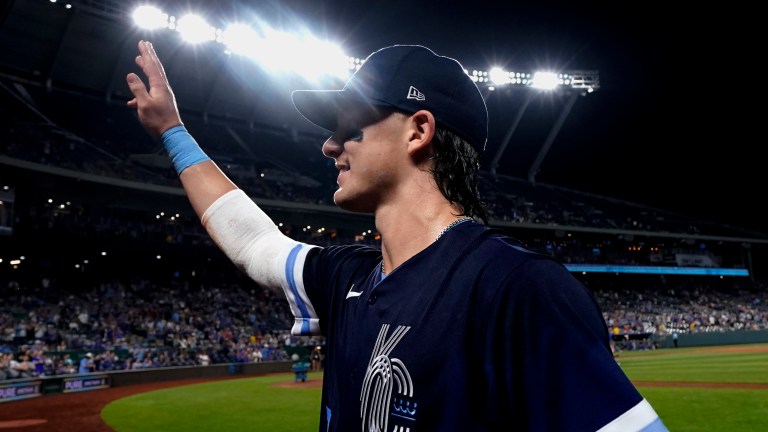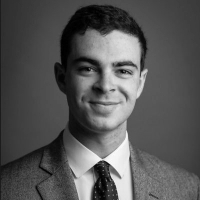10 Players Worthy of Pre-Arbitration Extensions
Kansas City's Bobby Witt Jr. stand out, but who else makes sense to pay long-term before their arbitration years?

On December 4th, Brewers outfield prospect and Just Baseball’s No. 3 overall prospect Jackson Chourio inked the largest contract extension ever given to a player yet to make his MLB debut.
At eight years and $82 million, with escalators and club options that could push the deal to $130 million over 10 seasons, it blows the previous record of Luis Robert Jr.’s six-year, $50 million deal out of the water.
The Chourio and Robert deals come around once in a blue moon in the baseball cycle. What has become far more common in the last several years, thanks in large part to former White Sox general manager Rick Hahn and current Braves general manager Alex Anthopoulos, are longer extensions given to players that have yet to reach their arbitration years.
Ronald Acuña, Ozzie Albies, Michael Harris and Spencer Strider are all examples of the Braves machine, but even larger-money deals around the league are being dished out to future franchise cornerstones. That list includes Fernando Tatis Jr. (14 years, $341 million in 2021), Julio Rodriguez (12 years, $209 million in 2022) and Corbin Carroll (eight years, $111 million this past spring).
Here are our best guesses as to which young talents in baseball could sign the next big pre-arbitration extensions.
Bobby Witt Jr. – SS – Kansas City Royals
Years of Team Control Remaining: 4
An electrifying talent, Witt’s unfinished approach at the plate and lack of consistent defensive home doused the fire on his rookie season and let a touch of doubt creep in regarding his ability to consistently produce. A year later, and those concerns are pretty much gone.
2022 Stats: 150 G, 2.3 fWAR, 98 wRC+, .254/.294/.428, 20 HR, 30 SB, -11 OAA
2023 Stats: 158 G, 5.7 fWAR, 115 wRC+, .276/.319/.495, 30 HR, 49 SB, 14 OAA
His flip of the switch defensively is utterly incredible, and much of it may be the fact that he called shortstop home all season as opposed to spending a third of his time at the hot corner, like he did in ’22. Still, that’d be selling his improvements short. A perennial 30/30 threat with elite defense at shortstop has the 23-year-old looking like one of the best players in the game, regardless of age.
If He Signed Tomorrow: 11 years, $235 million
Gunnar Henderson – SS/3B – Baltimore Orioles
Years of Team Control Remaining: 5
The unanimous American League Rookie of the Year, Henderson overcame a rough start to the season by slashing .281/.327/.541 (.868 OPS) with 22 home runs since June 1 (95 games). His 4.6 fWAR was sixth among all qualified shortstops, and he upped his defensive value by logging 13 Defensive Runs Saved while splitting his time nearly evenly between short and third base.
With one fewer year of control than when his prospect measuring stick in Corbin Carroll signed his extension, Henderson could command a higher AAV deal because of his used pre-arb season. However, Carroll still seems like the safer candidate to slap a hefty price tag on, given his speed and slight power advantages over Henderson. I don’t think I’m crazy for saying that he could sign an identical deal to Carroll’s while Baltimore buys out one more season on the open market.
If He Signed Tomorrow: Eight years, $111 million
William Contreras – C – Milwaukee Brewers
Years of Team Control Remaining: 4
Now that the three “big money” candidates are out of the way, Contreras starts a run of players that could command a team-friendly deal while still cashing in before hitting his three arbitration years.
Traded to Milwaukee last December in a deal that ultimately saw Sean Murphy land with the Braves, Contreras led all catchers with a 5.4 fWAR and was second to only Adley Rutschman with his 124 wRC+ in 2023. If Contreras were to sign a five-year extension fresh off of his first season as a full-time backstop in the big leagues, Milwaukee would buy out one pre-arb year, all three arbitration years, and one year in the open market before he hits free agency ahead of his age-31 season.
If He Signed Tomorrow: Five years, $60 million
George Kirby – RHP – Seattle Mariners
Years of Team Control Remaining: 5
Kirby is where things get a little tricky. The 25-year-old right-hander is our first Super Two player on this list, meaning that he earned himself a fourth arbitration year. If the Mariners were to talk extension with Kirby, they wouldn’t be paying for two years of the league minimum; instead, they’d be buying out one season where Kirby would earn the minimum $740,000 (2024) and an additional four of arbitration.
Pitcher extensions are a source of stress for every big league front office. However, Kirby should undoubtedly be the exception. Kirby is an elite strike-thrower, and has been since the moment he debuted. The active leader in BB/9 among pitchers with more than 1,000 IP is Kyle Hendricks at 1.99, while no other pitcher is under 2.00.
Kirby, in his first 320 MLB innings, sits at 1.2 BB/9 while sitting at 96 MPH with his fastball. If health is a non-issue, Kirby may have the highest floor of any arm in the game.
If He Signed Tomorrow: Six years, $80 million
Eury Pérez – RHP – Miami Marlins
Years of Team Control Remaining: 6
Pérez has the makings of a future Cy Young-caliber pitcher, and the 20-year-old showcased those abilities his first 91.1 MLB innings. At 6’8″, 220 pounds with mechanics as clean as most pitchers that stand just 6’0″, there is more to dream on with Pérez than any other pitcher in baseball, and maybe as much as any player overall.
If new President of Baseball Operations Peter Bendix were to talk extension with Pérez, he’d surely be gambling on the health of a young wunderkind. However, promising money up front is an intriguing offer for a pitcher who could very well rack up the millions in arbitration, all while wringing out an extra year of control on the back-end.
If He Signed Tomorrow: Seven years, $68 million
Junior Caminero – 3B – Tampa Bay Rays
Years of Team Control Remaining: 6
Much like Chourio, there is so much unknown with Caminero. However, Caminero does have his big league debut under his belt, playing in seven regular season games before appearing off the bench in both games of Tampa’s Wild Card appearance.
The 20-year-old had a far better year than Chourio did offensively, .324/.384/.591 with 31 home runs in 117 games between High-A and Double-A, compared to Chourio’s .280/.336/.467 slash line in 122 Double-A games. Caminero has continued his success in the highly-competitive Dominican Winter League, sporting a .936 OPS through 21 games while being nearly a decade younger than the average hitter in the league.
The main differences between these two are defensive ability and impact on the base paths. Chourio can be a stolen base machine, while Caminero is nearly a non-factor on the base paths.
Defensively, Chourio has capability in center field, while Caminero is an adequate defender who has pretty much made the full-time switch to third base. However, with Caminero impacting the ball consistently in a way that few other big leaguers can, there’s reason to believe his value could be seen as (contractually) identical to that of Chourio.
If He Signed Tomorrow: 8 years, $82 million
Gabriel Moreno – C – Arizona Diamondbacks
Years of Team Control Remaining: 5
Toronto has to be kicking themselves for moving Moreno instead of Alejandro Kirk, who underwhelmed in Year 2 as the starting catcher up north. Moreno, meanwhile, showcased his excellent defensive abilities behind the plate, resulting in a 1.7 fWAR through 111 games despite posting a wRC+ at just 103.
Diamondbacks general manager Mike Hazen has the chance to pounce before the big breakout from Moreno, which at this point feels inevitable. As of this very moment, Moreno could be seen as relatively cheap. If Hazen and Arizona were to wait one more year for him to complete his maturation, this deal may be seen as borderline disrespectful.
If He Signed Tomorrow: Eight years, $70 million
CJ Abrams – SS – Washington Nationals
Years of Team Control Remaining: 5
Much like Moreno, Abrams is a not-yet finished product that has plenty of MLB experience under his belt already. Abrams was jerked around from the big leagues, to Triple-A, and from coast-to-coast in a whirlwind of a rookie season in 2022 before serving as Washington’s everyday shortstop in ’23. Consistency and comfort were the names of the game for Abrams, who upped his wRC+ from 72 to 90 and his fWAR from -0.3 to 2.1 in the span of a year.
Even with the improvements, Abrams still serves as more a dream than a current star. While Abrams, like Kirby, is a Super Two player, the lack of track record should play into the Nationals’ hands if they do want to negotiate a leveraged deal with him.
If He Signed Tomorrow: Six years, $40 million
Jordan Walker – OF – St. Louis Cardinals
Years of Team Control Remaining: 5
The bat is the calling card for Walker, and it simply does not matter what position he plays — this contract could very well feel like a bargain if he was a full-time DH by Opening Day if all goes to plan with the stick.
The 21-year-old Walker was put in a pressure cooker at the outset, with St. Louis relying on the young bat to perform on Opening Day 2023. The quick-trigger promotion resulted in a lengthy hitting streak, but inefficiencies led to a Triple-A option about a month in. Walker showed resiliency once his number was called again, posting a 114 OPS+ in his first 117 major league games.
The Cardinals are in an interesting spot with Albert Pujols, Yadier Molina, and Adam Wainwright all now retired and Nolan Arenado and Paul Goldschmidt on the wrong side of 30. If John Mozeliak is looking to place a tag on a franchise cornerstone, Walker may have to be the guy.
If He Signed Tomorrow: Seven years, $85 million
Evan Carter – OF – Texas Rangers
Years of Team Control Remaining: 6
One of the darlings of the MLB Postseason, Carter may have some crazed Rangers fans still drunk on the joy of a World Series championship thinking that he’s a $100 million player. Let’s pump the brakes, but ever so slightly.
What Carter provided the Rangers down the stretch and through October was truly best case scenario, slashing .306/.413/.645 in his first 23 regular season games and OPS’ing .917 in the Postseason. Regression is expected. However, incredibly strong defense in a corner outfield spot and excellent patience with pull-side power to complement it have him looking like an everyday player with legitimate All-Star upside for a team that clearly has some money to burn.
If He Signed Tomorrow: Eight years, $70 million

